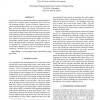Free Online Productivity Tools
i2Speak
i2Symbol
i2OCR
iTex2Img
iWeb2Print
iWeb2Shot
i2Type
iPdf2Split
iPdf2Merge
i2Bopomofo
i2Arabic
i2Style
i2Image
i2PDF
iLatex2Rtf
Sci2ools
129
click to vote
ISBI
2007
IEEE
2007
IEEE
Segmentation of Non-convex Regions within Uterine Cervix Images
The National Cancer Institute has collected a large database of uterine cervix images, termed “cervigrams” for cervical cancer screening research. Tissues of interest within the cervigram, in particular the lesions, are of varying sizes and complex, non-convex shapes. The current work proposes a new methodology that enables the segmentation of non-convex regions, thus providing a major step forward towards cervigram tissue detection and lesion delineation. The framework transitions from pixels to a set of small coherent regions (superpixels), which are grouped bottom-up into larger, non-convex, perceptually similar regions, utilizing a new graph-cut criterion and agglomerative clustering. Superpixels similarity is computed via a combined region and boundary information measure. Results for a set of 120 cervigrams, manually marked by a medical expert, are shown.
| Added | 03 Jun 2010 |
| Updated | 03 Jun 2010 |
| Type | Conference |
| Year | 2007 |
| Where | ISBI |
| Authors | Shiri Gordon, Hayit Greenspan |
Comments (0)

